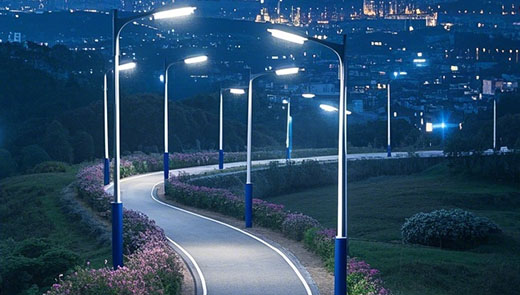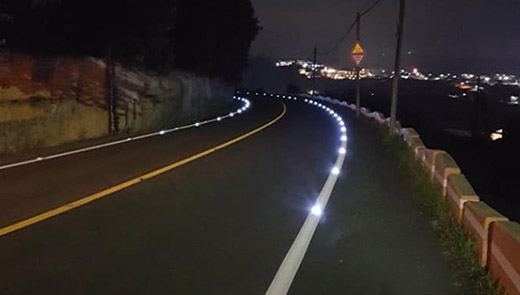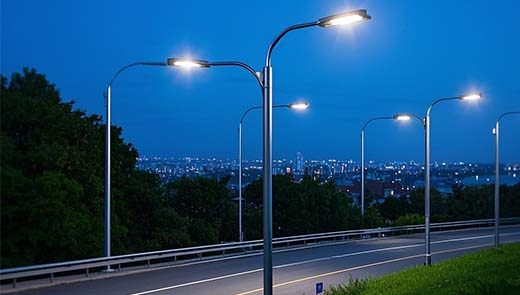Solar Street Lights in Winter: A Definitive Guide to Their Protection
On a cold winter night, when the outdoor area is dark, solar street lights will undoubtedly bring a lot of convenience and a sense of security if they light up the streets and alleys. However, many people wonder: can solar street lights work properly in winter? We will discuss this issue in depth, analyze the challenges faced by solar street lights in winter, and how to protect them and select the right products to ensure their best performance in winter.
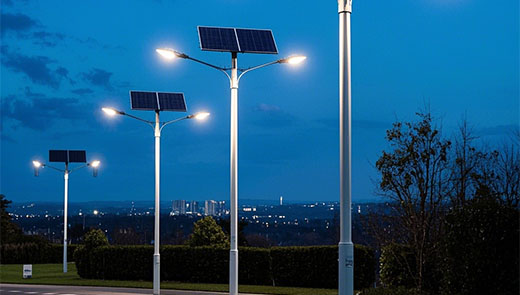
Do solar street lights work in winter?
Yes, outdoor solar street lights can be used in the winter, but there are a few things to consider. During the winter, these solar lights charge their batteries by absorbing sunlight during the day, which then powers the lights at night. However, the shorter hours of daylight in the winter, along with inclement weather such as snow and cloudy skies, can significantly reduce the amount of sunlight available for charging. Reduced sunlight exposure may prevent solar lights from fully charging, which can affect their performance.
Nonetheless, consumers benefit from advanced technology when they choose high-quality solar lights designed for winter use. These lights are equipped with high-efficiency photovoltaic cells that effectively convert weak sunlight into electricity. A powerful lithium-ion battery is also used to keep the lights functional in low light conditions. Notably, these winter solar lights are carefully designed to make the most of the limited charging time. They are designed to stay operational for as long as possible even in less than ideal weather conditions, ensuring reliable lighting throughout the cold season.
Why solar street lights struggle in winter
Dramatic reduction in daylight hours
In Stockholm, the capital of Sweden, for example, which is located at a high latitude, there are extremely long periods of sunlight in the summer, up to about 18 hours, and the sun is high in the sky for long periods of time, providing plenty of time for the solar panels to shine. In winter, however, the situation is quite different, with sunlight hours shortening dramatically to as little as 6 - 7 hours. This huge difference in daylight hours has a significant impact on the operation of solar street lights.Solar panels rely on absorbing sunlight to collect and store energy, and the short hours of sunlight in winter greatly reduce the amount of time solar panels can collect and store energy. This directly contributes to the inability to fully charge the batteries, leaving them with insufficient power reserves. Insufficient battery power further limits the length of time that solar street lights can illuminate at night, making it difficult to meet the demand for long-lasting lighting on city streets and causing inconvenience to residents traveling at night.
Weather-related challenges
Complex weather conditions in winter bring many challenges to solar street lights. Snow will cover the panel to reduce energy generation, by choosing 45-60 degrees of panel angle to facilitate the snow sliding down, and timely clean up the snow response; cloud cover without special countermeasures, mainly rely on the panel itself to use the scattered light to generate electricity; cold temperatures, the battery can be insulated, such as wrapped in a thick foam or a professional thermal insulation sleeve, while choosing a battery with good performance in low temperatures like lithium-ion batteries; for the frost and ice, it is necessary to install and maintain the panel correctly. Ensure that the panels are correctly installed and maintained to prevent frost and ice by utilizing the heat generated by their work.
Key features of solar street lights in winter
Highly efficient solar panels
Monocrystalline panels perform better in winter, with photovoltaic conversion efficiencies of up to 20-25%, while polycrystalline panels are typically 15-20% efficient. This means that monocrystalline panels can produce more electricity under the same light conditions. Monocrystalline panels respond better to low light, even on cloudy days or during the winter months when light is low, and can more efficiently convert light energy into electricity to recharge the batteries. When purchasing a solar street light, consumers must check the product specification to confirm the type of solar panel used and prioritize products with monocrystalline silicon panels.
Waterproof and dust proof design
The IP65 rating indicates that the solar street light is dust proof and waterproof. Among them, “IP” is the abbreviation of Ingress Protection, “6” means completely dust proof, and “5” means it can prevent water spray from any direction. “IP” stands for International Ingress Protection, “6” for complete dust protection and “5” for protection against the harmful effects of water spray from any direction.
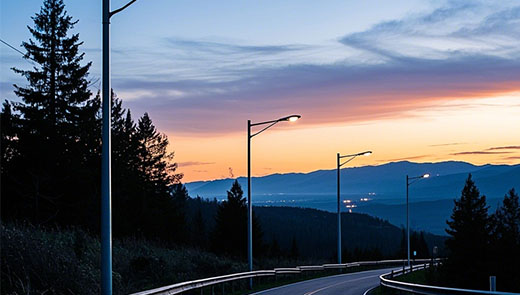
The role of durable materials
The use of durable materials such as ABS plastic or metal housings is of great significance for solar street lights, as ABS plastic is tough and has excellent impact resistance properties, effectively cushioning against external impacts. Metal housings, on the other hand, enhance the overall strength of the streetlight thanks to their sturdy construction. Both can withstand the erosion of winter wind and snow, reducing the risk of damage and thus significantly extending the product life of the solar street light.
Long-lasting battery
Lithium-ion batteries outperform other batteries at low temperatures, and their high energy density allows them to store more power. At -10°C, lithium-ion batteries can still maintain about 80% of their capacity, while lead-acid batteries may drop to less than 50% of their capacity. Lithium-ion batteries can hold their charge for a long time, providing a stable power supply for the solar street lights during long winter nights and ensuring the continuity of lighting.
Automatic on/off sensor
The built-in light sensor of the solar street light is like an intelligent “lighting housekeeper”, which is always keenly aware of the subtle changes in ambient light. In winter, the difference between day and night time is significant, and the sunshine time is shortened dramatically. When night falls quietly, the surrounding light gradually becomes darker, once it reaches a specific light intensity threshold, the light sensor will quickly respond, automatically triggering the circuit, accurately turn on the street lamp lights for pedestrians to light up the road. And when the day breaks, as the light gradually becomes brighter, the sensor can capture this change in time and turn off the lights automatically.
This automatic switching sensor plays a crucial role in winter when sunlight hours are short and access to solar energy is limited. It can accurately determine when the street light should be lit and extinguished, effectively preventing the solar street light from being lit up when it is not necessary, thus significantly reducing the unwarranted consumption of electricity, further extending the battery life, and ensuring that the solar street light can operate stably and efficiently throughout the winter.
Tips to ensure the best performance of solar street lights in winter
Panel angle and snow sliding
In snowy areas, the setting of solar panel angle is extremely critical to the normal operation of solar street lights. Practice and research have shown that it is ideal to set the solar panel at an angle of 45 - 60 degrees from the horizontal. This angle is skillfully used with the help of gravity, when the snowflakes fall and pile up on the panel, under the traction of gravity, the snow can slide down along the surface of the panel more smoothly, which can greatly reduce the snow on the panel of the coverage time. When the angle of the panel is unreasonable, such as close to horizontal, a large amount of snow is very easy to cover the panel quickly, the light is difficult to penetrate, so that the charging process of the solar street light is completely stagnant, which leads to the street light can not work properly.
The panel at 45 - 60 degrees angle, whenever it snows, the snow can be piled up in a short period of time, and the solar panel can quickly restore the light to ensure that the street light is stable power supply, to protect the normal lighting of the road in the winter night, and to provide security for pedestrians and vehicles passing by.
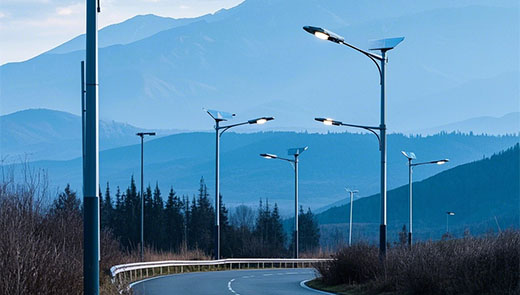
Snow clearing skills
Use a soft-bristle broom to gently sweep the snow on the solar panel, and be careful to avoid scratching the panel. For large-scale solar street light installation projects, snow melting system can be used. This system utilizes the small amount of electricity generated by the solar panels during the day to heat the panels slightly, preventing snow from adhering and ensuring that the panels continue to work. Getting into the habit of regularly cleaning up snow, such as cleaning up in time after the snow every morning, can ensure that the solar street light collects energy uninterruptedly and maintains stable lighting.
Battery insulation
Battery performance is greatly reduced in low temperatures, and lead-acid batteries perform especially well. Low temperature slows down the internal chemical reaction rate of lead-acid batteries, electrolyte viscosity increases, ion mobility difficulties, resulting in increased internal resistance of the battery, charging and discharging efficiency and capacity is greatly reduced. Battery insulation can effectively improve this situation. You can use thick foam or professional insulation sleeve to wrap the battery.
Thick foam has a lot of tiny pores filled with air, and air is a poor conductor of heat, can block the heat transfer; professional thermal insulation sleeve using special insulation materials, excellent thermal insulation. Both form an insulating layer around the battery, reducing heat loss. Research shows that in - 10°C environment, the capacity of un insulated batteries decreases seriously, while wrapped with thermal insulation material, the battery capacity can be increased by 30 - 50%, which provides strong support for the continuous and stable illumination of the solar street light in the cold winter night, and guarantees the safety of traveling at night.
Use of backup battery
The lithium-ion backup battery has stable performance at low temperatures, and when the main battery runs out of power due to snow-covered panels, the backup battery can supply power in time to ensure the continuous illumination of the street light. Combined with advanced technologies such as adaptive lighting and intelligent sensors, the adaptive lighting can automatically adjust the light brightness according to the ambient light and battery power, while the intelligent sensors can detect snow and automatically activate the snow melting system or adjust the angle of the panels, which further improves the reliability and efficiency of the solar street light in winter.
Energy saving mode
In winter, some advanced outdoor solar street lights are equipped with an intelligent energy saving mode, which provides strong support for their efficient operation in the cold season. This energy-saving mode has a flexible adjustment function, users can choose to reduce the brightness of the street light according to the actual lighting demand. In the middle of the night when pedestrians are scarce, or in areas where there is other auxiliary lighting in the surrounding environment, moderately lowering the brightness of the light not only meets the basic lighting needs, but also saves significant energy.
This feature is significant from the point of view of energy utilization and equipment maintenance. During the winter months, when solar energy is relatively difficult to obtain, lowering the light settings reduces power consumption and allows limited power to be used more consistently. Moreover, lower operating brightness reduces the load on the bulb and related circuit components, minimizing heat generation and wear and tear, which effectively extends the service life of the street light and ensures stable lighting throughout the winter.
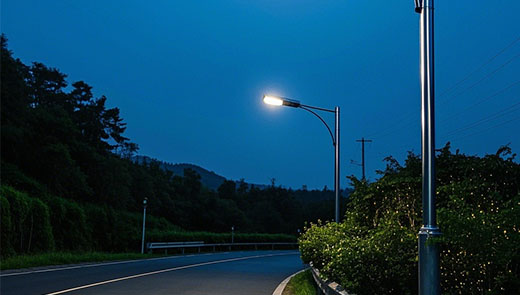
How to choose the right winter solar street light
Prioritize solar street lights with sturdy housings and internal components designed for cold temperatures. These street lights can withstand the impact of snow and ice, and the internal components work well in extremely cold conditions. Ideal winter solar street lights should be able to operate properly in temperatures as low as -25°C. When purchasing, carefully check the cold rating parameters in the product description. Choose a product with a battery capacity of 3000mAh or above, as a large capacity battery can store more power during the limited winter sunlight hours and ensure long time lighting at night.
Read reviews from other consumers to know how the solar street light performs in the actual winter environment. For example, whether it can charge properly on cloudy days, whether the brightness is stable at low temperatures, etc. Get references from real user feedback. Although the price of high-quality winter solar street lights may be higher, their durability and stability can avoid frequent replacement and save costs in the long run. A single investment in a high-quality product can provide reliable lighting for many winters, offering a higher cost-effective price.
Solar street lights face challenges such as shorter daylight hours and inclement weather in winter, but they still work well with modern technology support, such as high-efficiency photovoltaic cells and lithium-ion batteries. Choosing products with high-efficiency solar panels, waterproof and dust proof designs, long-lasting batteries and automatic switching sensors, and taking appropriate protective measures, such as adjusting the angle of the panels, clearing snow in time, and insulating the batteries, can significantly improve their performance in winter. When purchasing, pay attention to the product's cold-resistant design, specifications and parameters and refer to user reviews for long-term investment considerations. We hope that with this knowledge, you will apply what you have learned to make wise decisions when purchasing winter solar street lights or maintaining existing solar street lights, so that solar street lights will continue to bring light and safety to the streets during the cold winter months.

